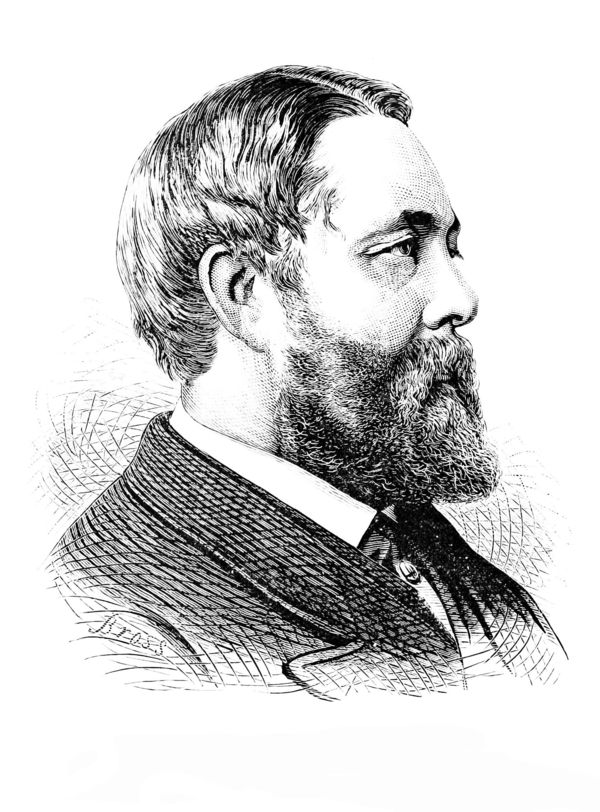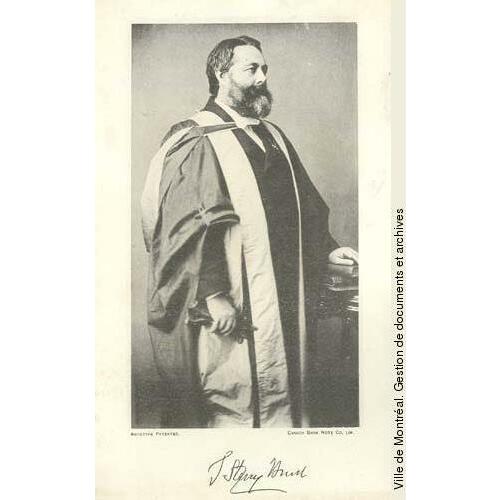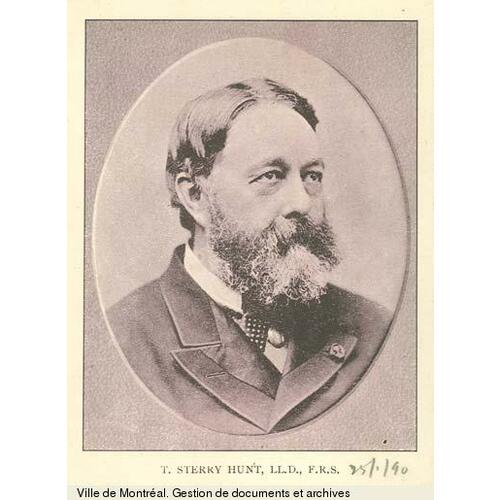
Source: Courtesy of Wikimedia Commons
HUNT, THOMAS STERRY, chemist, geologist, professor, and author; b. 5 Sept. 1826 in Norwich, Conn., son of Peleg Hunt, a merchant, and Jane Elizabeth Sterry; m. 23 Jan. 1878, at Christ Church Cathedral in Montreal, Anna Rebecca Gale, eldest daughter of the late judge Samuel Gale*; they had no children and separated in 1884; d. 12 Feb. 1892 in New York.
Thomas Sterry Hunt’s parents were descended from a long line of New England Puritans. The eldest of six children, he was 12 when his father died. Forced to go to work for the support of his family, he took various humble jobs which did, however, afford him a little time to study on his own. He was fortunate enough to attract the attention of the two Benjamin Sillimans, father and son, who were then both professors at Yale College. From 1845 to 1847 he worked as assistant chemist in the laboratory of the younger Silliman, and in the process he broadened his grasp of science.
In December 1846, on the recommendations of Silliman and of James Dwight Dana, Hunt was appointed chemist and mineralogist on the Geological Survey of Canada; he took office at the start of the following year. Working under the survey’s director, geologist William Edmond Logan*, he began studying the crystalline rocks of eastern Canada, sulphate and phosphate deposits, the oil resources in the southern part of Upper Canada, and the composition of mineral waters. He was the first to draw attention to the oil deposits in anticlinal structures and gave to Canadian geology the terms Laurentian, Norian, Huronian, Taconian, and Keweenian. In explaining the origins of crystalline rock formations, he developed around 1867 his crenitic hypothesis, a theory relying largely on chemical reactions to explain the composition and distribution of metamorphic rocks. While continuing with his scientific research, in 1856 Hunt was appointed professor of chemistry and mineralogy in the Université Laval at Quebec. However, during the years 1864 and 1865, he turned most of his energies to the establishment of the Séminaire de Québec’s museums, and he resigned his professorship in 1868. He also taught at McGill College in Montreal from 1862 to at least 1868. As an eminent figure in the scientific community, he helped organize the convention of the American Association for the Advancement of Science held in Montreal in 1857, and he represented Canada at the universal expositions of 1855 and 1867 in Paris.
In 1872 Hunt, whose scientific renown was at a peak in both North America and Europe, was appointed professor of geology and mineralogy at the Massachusetts Institute of Technology in Cambridge. Tiring of teaching, he resigned six years later to devote his energies to scientific research, public speaking engagements, and work for various mining companies. A charter member of the American Association for the Advancement of Science from 1849, and a fellow of the Royal Society of London from 1859, he continued his distinguished role in a number of scientific organizations during the latter part of his life. Elected to the National Academy of Sciences in 1873, he played an active role in planning the first international geological convention, which took place in Paris in 1878. He was president of the American Chemical Society in 1880 and 1888.
A pioneer in the field of geochemistry in North America, Hunt was interested in the origin and composition of such natural substances as gas, water, oil, minerals, and ores. His scientific bibliography includes over 350 titles. In the realm of applied science, it was he who perfected the green ink used by the United States Treasury in printing money. He also developed in collaboration with James Jr a method for the extraction of copper. However, his credibility with geologists of his day was weakened by two factors: his reliance on chemistry to explain geological phenomena, and the speculative nature of many of his theories, which were influenced by his study of Kant, Hegel, and the naturalist philosopher Lorenz Oken. In the field of chemistry also, his opposition to the atomic theory of matter reduced his influence upon his colleagues.
Yet Thomas Sterry Hunt’s role in the developing scientific community of 19th-century Canada should not be underestimated. His scientific research drew the attention of both European and American scientists to the country. As well, amongst those Canadian organizations with which he was associated, the Geological Survey, McGill College, and the Université Laval benefited enormously from his energies and talents. After leaving the Geological Survey, Hunt remained a prominent figure in Canadian circles, and he was instrumental in founding the Royal Society of Canada, of which he was vice-president in 1883–84 and president in 1884–85.
A nearly complete list of Thomas Sterry Hunt’s scientific works is given in the biographical account by James Douglas, “A memoir of Thomas Sterry Hunt,” American Philosophical Soc. (Philadelphia), Memorial volume (1900): 63–121. His most important publications are The geology of Canada (Montreal, 1863), written in collaboration with Sir William Edmond Logan; Chemical and geological essays (Boston, 1875); Mineral physiology and physiography; a second series of “Chemical and geological essays” with a general introduction (Boston, 1886); A new basis for chemistry; a chemical philosophy (Boston, 1887); and Systematic mineralogy based on a natural classification (New York, 1891). All of these have been reissued except The geology of Canada.
ANQ-M, CE1-63, 23 févr. 1878. ASQ, Fonds C.-H. Laverdière; Fonds Viger-Verreau; Séminaire; Univ. Columbia Univ. Libraries, Dept. of Special Coll. (New York), F. A. P. Barnard papers; C. F. Chandler papers; Columbiana
Cite This Article
Raymond Duchesne, “HUNT, THOMAS STERRY,” in Dictionary of Canadian Biography, vol. 12, University of Toronto/Université Laval, 2003–, accessed December 31, 2025, https://www.biographi.ca/en/bio/hunt_thomas_sterry_12E.html.
The citation above shows the format for footnotes and endnotes according to the Chicago manual of style (16th edition). Information to be used in other citation formats:
| Permalink: | https://www.biographi.ca/en/bio/hunt_thomas_sterry_12E.html |
| Author of Article: | Raymond Duchesne |
| Title of Article: | HUNT, THOMAS STERRY |
| Publication Name: | Dictionary of Canadian Biography, vol. 12 |
| Publisher: | University of Toronto/Université Laval |
| Year of publication: | 1990 |
| Year of revision: | 1990 |
| Access Date: | December 31, 2025 |





